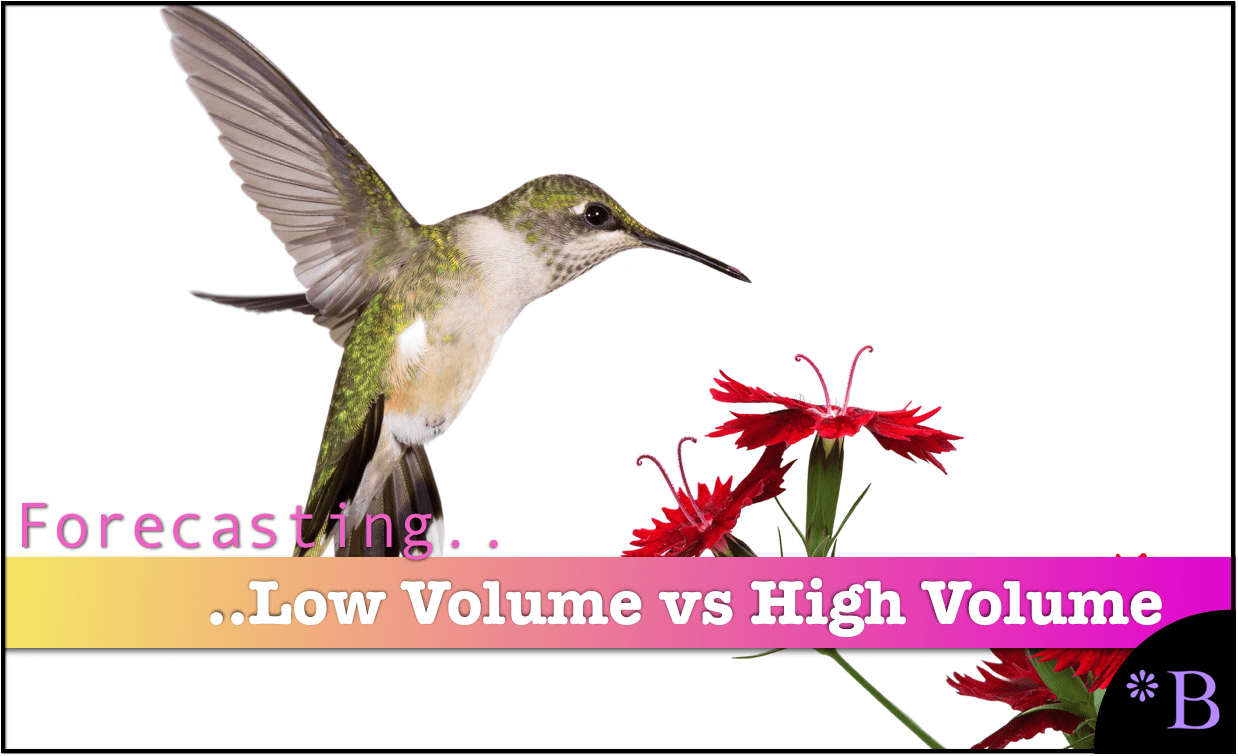How to Forecast Low Volume, High Dollar Items
Executive Summary
- Sales forecasting is little covered in books.
- It is necessary to understand the limitations of low volume sales forecasting.
- Sales forecasting output can be used for supply chain forecasting. However, it must be checked and frequently adjusted for sales or quota bias.

Introduction to Low Volume/High Dollar Forecasting
In performing research into forecasting, what is interesting is how much misinformation many articles on sales forecasting contain. I think this is because those who have never studied traditional forecasting write many articles on sales forecasting. However, sales forecasting is a sub-topic within the overall study of prediction, and excellent sales forecasting practices can’t just be made up or sharply diverge from good practices in forecasting.
Sales Forecasting Information and Books?
Interestingly, while there are many books written on forecasting, there are very few written on sales forecasting. And most people that perform sales forecasting have other responsibilities. I quote from one of these few books on sales forecasting:
“Experts seldom make every company forecast. Many are made by people who have numerous job responsibilities other than sales forecasting. Out of the hundreds of thousands of business people who make sales forecasts every year, only a few are proficient. This is especially true in sales and marketing departments, where managers seldom do anything more sophisticated than calculated and apply growth rates in Excel.” – Sales Forecasting
In this article, I will go through a significant sales forecasting feature that is mostly not acknowledged. However, it is crucial to consider setting appropriate goals for forecast accuracy.
Understanding the Limitations of Low Volume Sales Forecasting
For some reason that does not seem to be brought up in writing on the topic, sales forecasts for higher-value goods are subject to the same problem as small volume products like service parts.
“That is right, those things that we buy only when we need them. Well, it turns out there is a large body of work that explains how to forecast service parts, and the rules of service parts forecasting can be applied to small volume sales forecasting. I have included the demand history of a typical service part in the following graphic.
Service parts often have months of either 0, 1, 2 or 3 sales. This makes prediction tough. This means that the likelihood of accurate forecasting is naturally low. This is the nature of forecasting low volume or low occurrence events. Any prediction method that is used will result in a high error because the problem is a difficult one to solve. If a person who forecasted services parts were measured the same way as an individual who predicted a high volume product, the comparison would be unfair.”
Sales Forecasting Customers
Salespeople and sales departments frequently forecast the customer. Each salesperson often has an inkling of how much a customer will buy. However, they are generally focused on their quota attainment rather than forecasting in a way that allows the customer to be fulfilled. When selling services or software, salespeople, as a matter of routine, raise the expectations of the services or the software. There is often no way for the customer to be satisfied. When selling services, again, promises are made for delivery that is often not attainable. In both circumstances, salespeople will often lambast those in operations not to meet their declarations.
People often, and erroneously, think that forecasting by the customers is useful and can lead to more accuracy.
In their Supply Chain Planning Magic Quadrant report, Gartner stated that Big Data is going to allow more forecasting by the customer rather than the forecasting by-product, which I will explain in a future article, will not lead to improving forecasts.
The author for Gartner is mistaken. Forecasting by the customer is not great because customers are not as predictable as the product’s demand. This has been a misunderstanding of forecasting that goes far back and is still repeated within sales organizations.
Using the Sales Forecasting Output for Operations
For operations, the critical feature to forecast is what is sold, not who the customer is. Forecasting by a customer is pertinent for sales because customers are assigned to individual salespeople; therefore, each salesperson offers their market domain expertise to develop their forecast. However, items that are sold and when and where they are sold are critical to operations. It is much easier to forecast whether a certain business amount will be done than whether a particular customer will convert.
Finally, the issue is that outside of sales, using as a measurement (although how much they get out of it is debatable), forecasting is supposed to be used for operations. However, unless a particular level of accuracy can be attained, a sales forecast is not useful for operations. Operations need to know specifics — not revenue, and not a customer, but what is going to be necessary and also…..when. Is the sale for one apple, two oranges, or for three bananas — each may result in a dollar value of $3, but operations need to which fruit to stock up on, or in services which skills sets to stock up on, etc…
Conclusion
Forecasting by customer sounds great, but in reality, it is far more involved than is generally understood, and it means putting extra effort into the forecast. For large, expensive items, it makes more sense than for more numerous, less expensive items.
So its benefit really depends upon that relationship regarding the number of units sold and each item’s cost.